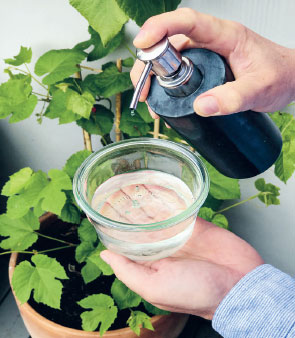
Insects on potted plants are not nice – or rather, they’re creepy. I’ve actually had them visiting and they cause me a lot of anxiety. Fortunately, there are a lot of folk remedies for getting the better of pests and insects. I’ve found over 100 of them while researching for this book – though some could be described as better substantiated than others. The advice about putting your plant in the microwave to get rid of aphids is not something I’d set much store by!

THE FRUIT FLY TRAP
You will need: a glass, water, vinegar and washing-up liquid.
1. Half-fill the glass with vinegar (about 100ml/3fl oz), and top up with water (about 100ml/3fl oz) so that you have a 50/50 mixture of vinegar and water. Add one drop of washing-up liquid.
2. Place the glass near to the pot you suspect of harbouring fruit flies/fungus gnats. The bigger the problem, the more traps you can put out.
3. The fruit flies/fungus gnats will seek out the mixture (they are attracted to the scent of vinegar), land on the top of it, become trapped and sink to the bottom of the glass.
I often leave a fruit-fly trap out during the warmer months, just behind the plant pots. It regularly catches any fruit flies or fungus gnats that are about – and as soon as the mixture has evaporated, I fill it up again.
Don’t forget that you only need to use pesticides when the plant is suffering from a bad attack. Check plants in the shop before taking them home: if you buy healthy plants and look after them well, then in theory you should be able to avoid both insect attacks and disease. There’s a vast range of different pests, but I’ll just concentrate on some of the most common ones that affect potted plants – as well as some effective ways of getting rid of them.
FRUIT FLIES
The most important measure is to make sure that your houseplants are not too wet. If you get an infestation, allow the soil to dry out thoroughly. Yellow glue traps can help. My best tip is the fruit fly trap. This is a simple, environmentally friendly and effective way of getting rid of fruit flies, though it’s also effective against the notorious little fungus gnats that often pop up in the summer – especially in homes where bananas and other types of fruit or food leftovers are left out.
APHIDS, MILDEW AND SPIDER MITES
Make your own environmentally friendly insecticide from cooking oil and a mild liquid soap. The oil forms a suffocating coating on aphids, mites and eggs, while the soap dries them out.
Mix 2 tablespoons of vegetable oil, 3 tablespoons of liquid soap and 250ml (8fl oz) of water in a spray bottle and spray over the entire plant.
If it’s a really bad attack, repeat after 1–2 weeks. It’s a good idea to test the mixture on just one leaf at first, just to make sure that your plant can tolerate it.
LIQUID SOAP AGAINST PESTS
Some people swear by liquid soap and have achieved good results washing their pest-stricken plants with a diluted mild liquid soap. There are two methods to choose from:
The bucket method
Fill a large bucket with water and add about a dessertspoon of a mild liquid soap. Stir in well. Turn the plant upside-down and slowly dip the plant up and down in the bucket. Afterwards, rinse the plant using clean lukewarm water, ideally in the shower. Only the green parts of the plant and the stem need to be immersed – not the soil in the pot.
The massage method
Carefully wash and massage the leaves and the stem in diluted mild liquid soap as above, remembering to wash particularly carefully underneath the leaves all the way to the stem.
CAN CLEAN, LUKEWARM WATER HELP AGAINST PESTS?
Yes, it is worth testing this simple method. Myself, I’ve found that washing plants in the shower or in the basin using clean, lukewarm water works well. Thoroughly washing the leaves – on top and underneath, as well as the stalks – will often be enough to get rid of these pests. I’ve also found that it helps to carefully massage leaves with my fingers to ensure that insects, spider mites etc. are washed off.
POISON – WHEN ALL ELSE FAILS
I have been forced to resort to chemicals, albeit very rarely. This should be avoided if possible, but if you have a plant that is particularly valuable or big and which is that bit special to you, you can use an insecticide. I decided to get hold of a chemical aphid spray when my 2m (6½ft) orange tree was attacked by aphids – and it worked. However, I do try to limit my use of chemicals to situations where my entire plant collection is at risk. If you get mealy bugs, you can try removing them using cotton buds dipped in methylated spirit. Unfortunately, it’s really difficult to get rid of this much-feared bug, and you have to consider throwing the plant out to prevent it infecting other plants. Better luck next time!